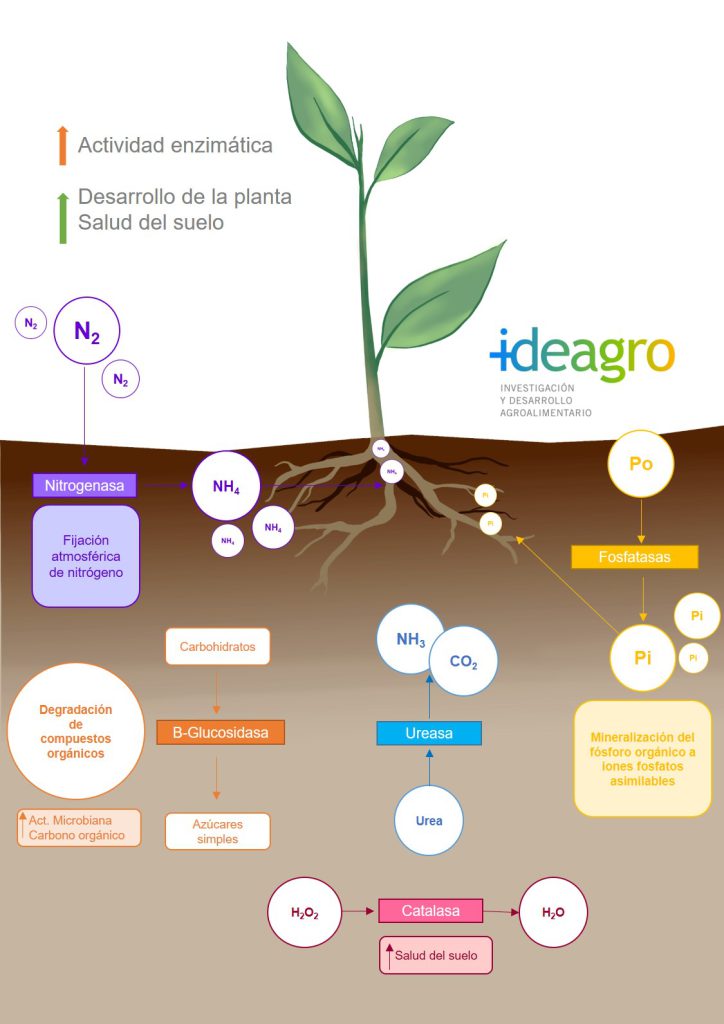[:en]Soil is a non-renewable and essential resource for the development of life, sustenance of plants, animals and humans. For this reason, in agriculture, it is essential to know its state of health and its quality for the proper growth of crops. whatBut do we know how much and how it degrades? Or if he recovers? Are we capable of obtaining precise data on everything that really happens under the surface?
The physical-chemical analyzes used up to now in agriculture provide us with information on the availability of nutrients or the percentage of organic matter. Along with it, the physical indicators allow to know the texture or the degree of compaction. However, the x-ray will remain incomplete as long as a determining aspect is not taken into account: the biological factor.
The objective, therefore, is to obtain a global vision of the soil, for which it is essential to also study the influence of microorganisms. And at this point, the challenge is to establish an adequate method of interpretation and measurement of biological analyses.
Given this, in IDEAGRO we want to offer answers: we are developing a soil quality index based on new indicators and thanks also to the history of samples that we have evaluated over the years.

Enzymes as an indicator
Microorganisms are involved in almost all processes that occur in the soil, and the vast majority are catalyzed by enzymes. Enzyme activity is very sensitive to environmental changes. and to various biotic and abiotic stresses, which makes them a good indicator of soil quality.
For example, an increase in temperature can lead to a decrease in enzyme activities, reducing the release of nutrients into the soil. In addition, enzymes are directly related to the activity and composition of a certain microbial population, providing more information on the health status of the soil.
Enzymes and nutrients in the soil
Some hydrolase-type enzymes play a key role in the cycles of nutrients in the soil, such as nitrogen (urease), phosphorus (phosphatase) and carbon (β-Glucosidase), making these nutrients available to the plant and other microorganisms, essential for their growth.
Therefore, evaluating the enzymatic activity of a soil provides us with more information and in a more precise way, than, for example, the concentration of a nutrient in the soil, which can be a very complete indicator for the establishment of a quality index.
Doctoral thesis to better evaluate the soil
Our colleague Miriam López is going to deepen the study of those parameters, variables and representative values that allow the evaluation of soil quality thanks to a industrial doctoral scholarship at the University of Murcia and in collaboration with the Center for Soil Science and Applied Biology of Segura (CEBAS-CSIC).
Dr. Alexia Stellfeldt, project manager at IDEAGRO and with extensive experience in microorganisms and soil health, and Dr. Carlos García Izquierdo, research professor at CEBAS-CSIC and researcher in the Department of Soil and Water Conservation and Management of Organic Waste, will be the thesis directors in charge of guiding and helping Miriam López with the aim of being able to apply the results to agricultural soils and improve the quality and sustainability of our soils.
Bibliography
- Doran, J., Parkin, T. 1994. “Defining and Assessing Soil Quality”. Soil Science Society of America, 3 – 21
- Northcliff, Stephen. 2002. “Standardization of soil quality attributes”. Agriculture, Ecosystems and Environment, 88, 161-168.
- Bastida, F., Zsolnay, A., Hernández, T., & García, C. 2008. Past, present and future of soil quality indices: A biological perspective. Geoderma 147:159–171
- Sarmiento, E., Fandiño, S., Gómez, L. 2018. Soil quality indices. A systematic review. Ecosystems 27(3):130-139. Doi.:10.7818/ECOS.1598
- Karlen, DL, Mausbach, M., Dorán, J., Cline, R., Harris, R., Schuman, G. 1997. Soil Quality: A Concept, Definition, and Framework for Evaluation (A Guest editorial). Soil Science Society of America Journal 61(1): 4-10.
- Garcia-Izquierdo, Carlos (2003). Analysis techniques of biochemical parameters in soils: measurement of enzymatic activities and microbial biomass
[:]










